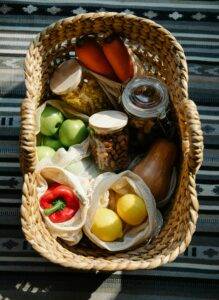The holidays are a time of joy, family gatherings, and plenty of food. For parents, this season brings some challenges to maintaining healthy holiday meals, especially with children in the mix. Rich meals, sugary desserts, and snacks are abundant during the festive season, so it’s perfectly fine to indulge.
But you may be wondering about healthier options that your children will enjoy. The good news is that you don’t have to compromise between holiday traditions and your desire to provide nutritious meals for your children. With a few simple swaps and creative dishes, you can still enjoy all the magic of the season while ensuring your little ones eat balanced, wholesome meals. This article will explore how to make healthy holiday meals for children that will keep everyone happy and nourished throughout the season.
Why Nutrition is Crucial in Holiday Meals
It’s no secret that holiday meals are often indulgent, with many traditional dishes containing excess sugar, fat, and processed ingredients. For children, who are still growing and developing, these types of foods lead to unwanted effects such as mood swings, lower energy levels, and even an increased risk of unhealthy weight gain.
While it’s perfectly fine to enjoy holiday treats in moderation, it’s also essential to maintain some structure in your child’s nutrition. Incorporating nutrient-dense foods into their meals ensures the vitamins and minerals to stay healthy. This is particularly important during winter when children’s immune systems need extra support to ward off seasonal colds and flu.
The Importance of Balanced Nutrition for Children
Let’s break down why maintaining good nutrition during the holidays is essential for children:
- Steady energy: Nutritious foods provide a more stable energy source than sugary or processed treats, helping kids stay active and alert throughout the day.
- Better mood: Nutrient-rich foods like fruits, vegetables, and proteins support stable mood regulation, making your children feel their best even during a season of excitement and chaos.
- Stronger immune system: A balanced diet that includes vitamins (like vitamin C) boosts your child’s immune system, making it easier to fight winter colds and flu.
- Building lifelong habits: By making healthy meals fun and delicious during the holidays, you teach your children that nutritious foods can be enjoyed year-round, not just on special occasions.
Key Nutrients for Kids’ Health During the Holidays

Certain nutrients support children’s health, especially during the holiday season. Here’s a quick breakdown of the key nutrients to focus on:
- Protein: Supports growth and muscle development. Opt for lean meats like turkey, chicken, or plant-based proteins.
- Fiber: Helps keep digestion regular and prevents the sluggishness from overeating rich holiday meals. Whole grains, fruits, and vegetables are excellent sources.
- Vitamins and minerals: Vitamin C (found in fruits like oranges and berries) boosts the immune system, while calcium (from dairy or fortified plant-based milk) is crucial for growing bones.
- Healthy fats: Omega-3 fatty acids (found in fish, nuts, and seeds) are essential for brain health and help stabilize moods.
Now that we understand the importance of nutrition, let’s dive into some practical strategies for creating delicious, healthy holiday meals your children will love.
Tips for Preparing Healthy Holiday Meals for Kids
Making healthy holiday meals doesn’t mean overhauling your entire menu. Thoughtful adjustments and additions transform traditional holiday dishes into more balanced, nutritious options. Here are some tips to get started:
1. Opt for Whole, Fresh Ingredients
One of the best ways to ensure your child is healthy is to focus on whole foods. Whole foods are ingredients that are minimally processed, retaining their natural nutrients. These foods are rich in vitamins, minerals, and fiber for children’s health development.

For your holiday meals, make whole foods the foundation of your menu. Fresh fruits and vegetables, whole grains, lean proteins, and healthy fats should be front and center. By doing so, you provide your kids with nutritious meals and set an example of how to make healthier choices year-round. Your child gets more vitamins, minerals, and fiber in every bite when fresh ingredients are used. Plus, whole foods taste better and elevate your holiday meal without added sugar or unhealthy fats.
- Vegetables: Roasted Brussels sprouts, green beans, carrots, and sweet potatoes are great options that bring color and nutrients to the table.
- Fruits: Incorporate fruits like apples, cranberries, and pomegranates into salads or desserts.
- Whole grains: Substitute refined grains like white bread and pasta with whole grains such as quinoa, brown rice, or whole wheat bread.
- Lean proteins: Serve turkey, chicken, or plant-based proteins like lentils or tofu.
2. Make Healthier Versions of Traditional Holiday Dishes
Many holiday favorites are packed with extra calories and fat, but with a few smart substitutions, you lighten these dishes while still keeping them flavorful. For example, replace heavy cream with Greek yogurt or almond milk and use whole wheat flour instead of refined white flour.
Reduced sugar in desserts or natural sweeteners like honey or maple syrup is worth trying. These swaps ensure that your holiday meal is flavorful but with added nutritional value. Kids can still enjoy the foods they love, but in a way that supports their health. Here are some swap ideas for common holiday dishes:
- Mashed potatoes: Instead of heavy cream and butter, try mashing your potatoes with olive oil or Greek yogurt for a lighter option. Mix in steamed cauliflower to add fiber and vitamins without changing the flavor too much.
- Gravy: Traditional gravy is made with butter and flour. Instead, use vegetable or chicken broth and thicken with slurry. This reduces the fat and calorie content while keeping the gravy smooth and delicious.
- Stuffing: Use whole-grain bread instead of white bread and add extra vegetables like mushrooms, onions, and carrots. Use low-sodium broth to reduce salt content.
- Pies and Desserts: Reduce sugar content by half and use fruit-based sweeteners in baked goods. For example, unsweetened applesauce or mashed bananas can replace some sugar in cakes or cookies.
3. Prioritize Colorful, Nutrient-Rich Foods
Kids are naturally drawn to colorful, vibrant foods. Lucky for us, these foods are the most nutrient-dense! When planning your holiday meals, include varied colors on the plate. Each fruit and vegetable color represents a set of nutrients, so the more variety you offer, the more vitamins and minerals your child will get.
For instance, bright orange vegetables like sweet potatoes are rich in vitamin A, which supports healthy vision, while dark green veggies like spinach and broccoli provide calcium and iron. Red fruits like cranberries and pomegranates are antioxidants, protecting cells from damage. You can create fun dishes like a rainbow fruit salad or a veggie platter shaped like a Christmas tree to encourage your kids to eat a variety of colors.
- Red: Cranberries, pomegranate seeds, red bell peppers.
- Orange: Sweet potatoes, carrots, pumpkin.
- Yellow: Corn, yellow bell peppers, squash.
- Green: Green beans, peas, Brussels sprouts, spinach.
- Purple: Beets, purple cabbage, grapes.
4. Incorporate Protein-Packed Dishes to Keep Kids Full and Energized
Protein is an essential nutrient for children, supporting their growth, muscle development, and overall energy levels. During the holidays, it’s easy for kids to fill up on carbohydrates from bread and sugary treats, so ensure to include protein-rich options in your meals.
Turkey, a holiday staple, is a lean source of protein that makes a great addition to any meal. Plant-based proteins like beans, lentils, quinoa, and tofu are excellent alternatives for vegetarian families. Adding a protein-rich salad with nuts, seeds, or beans completes the meal and ensures your child gets enough of this important nutrient. Adding more protein to your holiday meals ensures your children feel fuller for longer and get the energy to stay active and happy throughout the day.
- Roasted Turkey: This lean meat is a traditional holiday favorite and an excellent source of protein.
- Chicken: For a lighter option, skinless chicken breasts or thighs work well for holiday meals.
- Fish: Incorporate fish like salmon or trout, which are rich in omega-3 fatty acids.
- Plant-based proteins: Beans, lentils, quinoa, and tofu are great sources.
5. Don’t Forget About Portion Control
During the holidays, it’s easy for children to get carried away with large portions and endless snacking. Encouraging portion control helps them enjoy all the delicious foods without overindulging. One way to do this is by offering small, balanced plates with a mix of proteins, vegetables, and grains.
You can also use kid-friendly plates with dividers for different food groups, making it easier to offer balanced meals. Teaching children to listen to their hunger cues is also crucial. You encourage them to eat slowly and stop when they feel full, rather than finishing everything on their plate out of habit.
Healthier Dessert Ideas:
- Fruit salad: A festive fruit salad made with apples, oranges, pomegranates, and cranberries can satisfy sweet cravings while providing essential nutrients.
- Baked apples: Core apples and fill them with oats, cinnamon, and a drizzle of honey for a naturally sweet treat.
- Greek yogurt parfaits: Layer Greek yogurt with fresh fruit and a sprinkle of granola for a fun and healthy dessert alternative.
By offering smaller portions of sugary desserts and balancing them with fresh, naturally sweet fruit options, you can help your child enjoy the holiday treats without overloading sugar.
Make Healthy Eating Fun: Involve Your Kids in the Kitchen
Getting your kids involved in cooking is one of the best ways to help them appreciate and enjoy healthier foods. Children try new dishes and eat what they’ve helped prepare, so let them assist you in the kitchen whenever possible.
Assign Simple Tasks: Younger children help with basic tasks like washing vegetables, mixing ingredients, or stirring pot. Older kids take on more responsibility by helping measure ingredients, chop vegetables (with supervision), or assemble side dishes. Involving your children in preparing holiday meals also allows you to teach them about where food comes from and why certain foods are good for their health.
Create a DIY Food Station: A DIY station for side dishes or desserts can excite kids about assembling their plates. Letting your children customize their meals allows them to feel more involved and gives them a sense of ownership over their choices, helping them develop healthy eating habits.
Healthy Holiday Meal Ideas for Kids
If you’re looking for inspiration, here’s a sample holiday menu that blends healthy, kid-friendly options while maintaining the festive spirit.
Appetizers
- Veggie platter with hummus: Serve colorful vegetables like baby carrots, cucumbers, and bell pepper slices with a side of hummus for dipping.
- Stuffed mushrooms: Use a mixture of whole-grain breadcrumbs, herbs, and a small amount of cheese to stuff mushrooms for a savory bite-sized appetizer.
Main Course
- Roasted turkey breast: A lean source of protein that’s sure to be a hit with kids.
- Whole-grain stuffing: Use whole-wheat bread and plenty of vegetables to lighten up traditional stuffing.
- Roasted sweet potatoes: Toss with olive oil and herbs for a naturally sweet, fiber-rich side dish.
- Steamed green beans with almonds: Green beans are always a crowd-pleaser, and the almonds add a nice crunch.
Dessert
- Baked apples with cinnamon: This naturally sweet dessert is warm, comforting, and packed with fiber.
- Greek yogurt parfait: Set up a DIY station where kids can layer yogurt, fruit, and granola for a healthy yet festive dessert.
Enjoy the Holidays with Healthy and Balanced Meals
While you offer healthy options during the holidays, don’t stress about perfection. Allow some room for indulgence and treat the holiday season as a time to enjoy the food and company without too much restriction. The goal is to teach your children that healthy eating is enjoyable and balanced, rather than focusing on strict rules.
For more tips on promoting healthy eating in children year-round, check out these articles:
- What to Do with Picky Eaters: 20 Ways to Promote Healthy Eating
- Pediatric Nutrition: Building Healthy Eating Habits With Your Pediatrician’s Help
With a little creativity and planning, create a holiday feast you and your children will love—while still supporting their health and well-being. Happy holidays!






